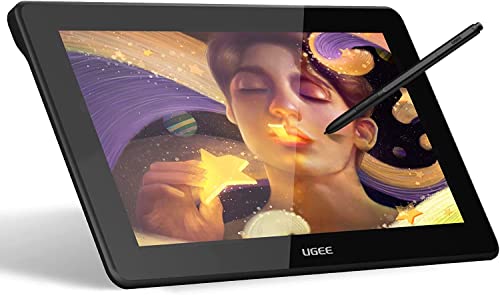If you are a first-time beginner or a professional artist looking to get into digital art, how much does a good drawing tablet cost?
It’s an important question. A good tablet for professional art and illustration will cost anywhere from $100 to $3000.
Budget-friendly drawing tablets start at around $100 and are a good option for beginners or hobbyists. They typically have smaller drawing areas and fewer features than more expensive tablets, but they can still be used to create high-quality digital art.
Mid-range drawing tablets cost between $200 and $500 and offer a good balance of features and affordability. They have larger drawing areas and more pressure sensitivity levels than budget tablets, making them a good choice for more experienced artists.
High-end drawing tablets cost over $500 and offer the best performance and features available. They have large drawing areas, high-pressure sensitivity levels, and advanced features such as tilt support and programmable buttons. These tablets are the best choice for professional artists and designers.
No matter what your budget or needs are, there is a drawing tablet out there that is perfect for you. This guide will help you choose the right tablet for your needs and get started with digital art.
Let’s discuss in more detail why there is such a wide price range.
How Much Does A Good Drawing Tablet Cost?
Before moving into the topic, you should know the types of tablets and their specifications. Check out the below table for more information on it.
| Attributes | Screenless Tablets | Display Tablets | Combination Tablets |
| Artistic Objectives | Basic sketching, doodling | Digital painting, 3D modeling | Versatile; both sketching and painting |
| Price Range | Economical | Premium | Mid to High |
| Portability | High; lightweight and compact | Moderate; often larger and heavier | Varies; depends on the mode |
| Compatibility | Generally high; fewer features | May require specific software | High; adaptable to various software |
| Learning Curve | Moderate; separate screen | Low; intuitive | Moderate; feature-rich |
| Pressure Sensitivity | Varies; generally lower | High; professional-grade | High; professional-grade |
| Real-Time Feedback | No; dependent on a computer monitor | Yes; draw directly on the screen | Yes; in display mode |
| Hands-On Experience | Less tactile feedback | High tactile feedback | High tactile feedback in display mode |
| Expert Recommendations | Good for beginners | Preferred by professionals | Offers best of both worlds |
Size Matters! When It Comes For Drawing Tablets, Of Course
The size of your graphics tablet will directly affect the price you pay. Larger drawing tablets cost more than their smaller alternatives. This is true whether it’s a drawing board or a tablet with a screen.

Screen Or No Screen
If you already have a fast PC or Mac with a decently sized screen, and you’re happy to have it with the most popular illustration and design software, you don’t need a graphics tablet with a display.
Drawing pads such as the Wacom Intuos range are much more affordable than screen drawing tablets. If you prefer to draw directly on the screen rather than a pad, you’ll need to be willing to invest more.
Some tablet screens still need your PC or Mac to work but provide the on-screen drawing experience. These large pressure-sensitive screens come in various brands, and the prices vary accordingly. Pressure sensitivity varies from brand and model to brand, so check the specification details when comparing.
The Tech Specs, What’s Under The Hood?
If you choose the best drawing tablet because you need it to run specific software with advanced features, you should check the tablet’s specifications before parting with your hard-earned cash.
For example, if you want to use Adobe Illustrator, Adobe Photoshop, or 3D modelling software, make sure your tablet supports pen and touch input for these apps, and make sure the specs run the programs. The key things to keep in mind are processor speed and RAM, as they affect the speed and smoothness of applications.
Hardware specifications include pressure sensitivity, number of hotkeys, Bluetooth or wired, battery or no battery, active area size and resolution, connectivity options, etc.
The Brand
Leading brands will always come at a higher price than lesser-known, affordable tablet alternatives. That’s not to say they’re necessarily better. Depending on your budget and needs, an unknown brand alternative could work very well.
One of my friends has been a professional illustrator for over 20 years; she uses the Wacom tablets, both pad-style and on-screen. She said she found it very reliable, easy, and great to use, and with interchangeable pen nibs, it’s easy to get the right feel for the pen.
Since they are very popular among top industry professionals, there is a lot of online support from other users. They are the best drawing tablets for drawing.
Size Of The Drawing Area
The bigger the tablet, the more expensive it tends to be. It’s no secret that artists and designers love having as much space as possible to express themselves; graphics tablet manufacturers know this.
It doesn’t matter if you are a beginner or an advanced user of graphics tablets. You will agree that a larger display is much more comfortable to draw on and instantly increases the user experience.
Sure, having a better pen (stylus), which has multiple levels of pressure sensitivity, is great. Still, it has little impact on the overall drawing experience compared to the size of the drawing space.
Computing Power
There is an even better graphics tablet for those on a slightly bigger budget. These devices are much more than graphics tablets; they are computers with touchscreen properties and can also be used as graphics tablets.
At the end of this article, I mentioned ordinary drawing tablets, which are drawing tablets with tracking capabilities. That translates pen movements into lines on a computer monitor.
What You’re Looking For Is A Standalone Drawing Tablet
Standalone graphics tablets contain absolutely everything you need to draw. Just install the desired software on them, such as Adobe Photoshop or Corel Painter, and use the pen (stylus) or even your fingers to draw on the screen.
These devices are the best graphics tablet ever created because they go beyond just being a peripheral resource; they are complete computers in their own right. The only disadvantage of standalone graphics tablets is that they are significantly more expensive.
What Makes A Good Drawing Tablet?
If you are not yet a pro and want to practice, there is no need to spend large sums of money on a device. Go for something simple that has been tried and tested over the years.
If you already have some experience and are already working (or at least considering starting work soon), be sure to pay attention to Huion KAMVAS GT-191. Right now, this is the best drawing tablet in its price range.
For those on a slightly higher budget, the Microsoft Surface Pro is a great option, not only because it’s a powerful computer but also because it’s so portable.
Buy Best Drawing Tablet
UGEE M708 Graphics Tablet
The UGEE M708 Graphics Tablet is a sleek, affordable, and reliable graphics tablet that is great for professionals and students.
This tablet is fully compatible with Photoshop, Illustrator, CorelDRAW, AutoCAD, Autodesk Sketchbook, and more.
Wacom Intuos Small Graphics Drawing Tablet
The Wacom Intuos small is the tablet that does it all! It has a larger tablet’s size, feel, and functionality for easier navigation but at a smaller scale for improved portability and space efficiency.
GAOMON PD1161 Tablet
With 8 Shortcut Keys and an 8192 Levels Pressure Sensitive Pen, this Drawing Tablet offers the convenience of both a graphic tablet and a pen display in one. You’ll be able to sketch, paint, and draw with various brushes, markers, pencils, and pens.
HUION KAMVAS Pro 16 Graphics Drawing Tablet
With HUION KAMVAS Pro 16 Graphics Drawing Tablet, you can be one step closer to this experience. Powered by a screen full-laminated tilt battery-free stylus, it offers an accurate drawing experience like never before.
Latest Trends in the Drawing Tablet Market
The drawing tablet market is undergoing a seismic shift, driven by technological innovations that are redefining the very essence of digital artistry. For those of you who are already experts in this domain, these trends offer a tantalizing preview of what the future holds.
Firstly, “Artificial Intelligence” is making a grand entrance. Features like predictive stroke technology are not just bells and whistles; they’re fundamentally changing the way artists interact with tablets. Imagine your tablet anticipating your next move and adjusting its settings in real time. It’s like having an assistant that knows you better than you know yourself.
Next, let’s talk about OLED displays. These are not your run-of-the-mill screens; they offer unparalleled colour accuracy and contrast. For professionals who can’t afford to compromise on visual fidelity, OLED is a game-changer. It’s akin to swapping out a blunt pencil for a set of high-end graphite and charcoal.
Multi-device synchronization is another trend that’s picking up steam. In today’s interconnected world, being able to transition from your desktop to your smartphone without missing a beat is not just convenient; it’s essential. It’s all about fluidity and making sure your creative process isn’t hampered by technological limitations.
Haptic feedback technology is also making waves. This feature brings the tactile sensations of traditional art mediums into the digital realm. Imagine feeling the texture of the canvas or the scratch of charcoal as you draw. It’s a sensory experience that adds a whole new layer to digital artistry.
Lastly, sustainability is becoming a focal point. Eco-friendly tablets made from recycled materials are entering the market, aligning with a growing global emphasis on sustainability.
In a nutshell, the drawing tablet market is a hotbed of innovation, offering artists an array of advanced features that promise to elevate the creative process to new heights. For those looking to stay ahead of the curve, these trends are not just noteworthy; they’re essential.
Conclusion
Digital artists need a graphics tablet that is affordable and easy to use. The best graphics tablets on the market will give you fantastic performance, accurate interactive pen display technology, and all the features you need for professional work.
Getting the right tablet will allow you to create and produce high-quality digital drawing work more efficiently than ever before, so it’s worth investing in the best you can afford right away.





![How Much Does a Good Drawing Tablet Cost 7 Simbans PicassoTab XL Drawing Tablet No Computer Needed with 11.6 Inch Screen [4 Bonus Items] Stylus Pen, Portable, Standalone, Android 11, Best Gift for Beginner Digital Graphic Artist - PCXL](https://m.media-amazon.com/images/I/517VMouBE-L._SL500_.jpg)


![How Much Does a Good Drawing Tablet Cost 10 Simbans PicassoTab Drawing Tablet No Computer Needed [4 Bonus Items] Drawing Apps, Stylus Pen, Portable, Standalone, 10 Inch Screen, Best Gift for Beginner Digital Graphic Artist -PCX](https://m.media-amazon.com/images/I/51zLm+fHzpL._SL500_.jpg)



